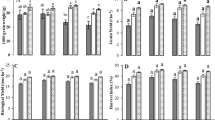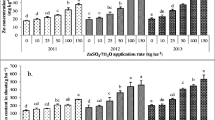Abstract
Background and Aim
Success in agronomic biofortification of maize and wheat is highly variable. This study aimed to elucidate the differences in uptake and translocation of foliar-applied zinc (Zn) in maize (Zea mays L.) and wheat (Triticum aestivum L.) using different experimental approaches.
Methods
Old leaves of plants cultured with low or adequate Zn supply in soil were treated with natural Zn (as ZnSO4) or enriched stable isotope 70Zn as SO4 salt. Treated leaves, and the remaining untreated shoot and roots were analyzed for Zn using quantitative (ICP-OES and ICP-MS after acid digestion) and qualitative (fluorescence microscopy after Zinpyr-1 staining) techniques.
Results
Application of Zn to a single old leaf resulted in significantly higher increments in Zn concentration of the treated leaf, remaining untreated shoot and roots in wheat than in maize, particularly under low Zn supply. The relative Zn uptake (i.e., the portion of 70Zn taken up by the treated leaf) was also estimated to be significantly higher in wheat than maize, irrespective of the rate of Zn supply to plants. Higher uptake and translocation of Zn in wheat compared to maize was also visualized and demonstrated by using Zinpyr-1 fluorescent dye.
Conclusions
Our results conclude that wheat is superior to maize in terms of leaf penetration and uptake, as well as subsequent translocation of foliar-applied Zn, therefore, the agronomic biofortification potential is better for wheat than for maize.

Similar content being viewed by others
Abbreviations
- ANOVA:
-
analysis of variance
- DMSO:
-
dimethyl sulphoxide
- EDTA:
-
ethylenediaminetetraacetic acid
- EDDHA:
-
ethylenediamine-N, N’-bis (2-hydroxyphenylacetic acid)
- ICP-MS:
-
inductively coupled plasma mass spectrometry
- ICP-OES:
-
inductively coupled plasma optical emission spectrometry
- w/v:
-
weight per volume
References
Alloway BJ (2008) Zinc in soils and crop nutrition, 2nd edn. International Zinc Association and International Fertilizer Industry Association, Brussels
Beach RH, Sulser TB, Crimmins A, Cenacchi N, Cole J, Fukagawa NK et al (2019) Combining the effects of increased atmospheric carbon dioxide on protein, iron, and zinc availability and projected climate change on global diets: a modelling study. Lancet Planet Health 3:e307–e317
Black RE, Victora CG, Walker SP, Bhutta ZA, Christian P et al (2013) Maternal and child undernutrition and overweight in low-income and middle-income countries. Lancet 38:427–451
Brian JA (2008) Micronutrients and crop production: an introduction. In: Micronutrient deficiencies in global crop production Ed. Springer, Berlin, pp 1–39
Broadley MR, White PJ, Hammond JP, Zelko I, Lux A (2007) Zinc in plants. New Phytol 173:677–702
Burdette SC, Walkup GK, Spingler B, Tsien RY, Lippard SJ (2001) Fluorescent sensors for Zn (2+) based on a fluorescein platform: synthesis, properties and intracellular distribution. J Am Chem Soc 123:7831–7841
Cakmak I (2000) Tansley Review No. 111. Possible roles of zinc in protecting plant cells from damage by reactive oxygen species. New Phytol 146:185–205
Cakmak I (2008) Enrichment of cereal grains with zinc: Agronomic or genetic biofortification? Plant Soil 302:1–17
Cakmak I (2014) Agronomic biofortification. In: HarvestPlus. Biofortification Progress Briefs. HarvestPlus, Washington, DC, 82 pp
Cakmak I, Kutman UB (2018) Agronomic biofortification of cereals with zinc-a review. Eur J Soil Sci 69:172–180
Cakmak I, Sari N, Marschner H, Kalayci M, Yilmaz A, Eker S, Gülüt KY (1996) Dry matter production and distribution of zinc in bread and durum wheat genotypes differing in zinc efficiency. Plant Soil 180:173–181
Cakmak I, Kalayci M, Kaya Y, Torun AA, Aydin N, Wang Y et al (2010a) Biofortification and localization of zinc in wheat grain. J Agri Food Chem 58:9092–9102
Cakmak I, Pfeiffer WH, McClafferty B (2010b) Biofortification of durum wheat with zinc and iron. Cereal Chem 87:10–20
Dionisio G, Uddin M, Vincze E (2018) Enrichment and identification of the most abundant zinc binding proteins in developing barley grains by Zinc-IMAC capture and nano LC-MS/MS. Proteomes 6:3
Erenoglu EB, Kutman UB, Ceylan Y, Yildiz B, Cakmak I (2011) Improved nitrogen nutrition enhances root uptake, root-to-shoot translocation and remobilization of zinc (65 Zn) in wheat. New Phytol 189:438–448
Fernández V, Brown PH (2013) From plant surface to plant metabolism: the uncertain fate of foliar-applied nutrients. Front Plant Sci 4:289
Fernández V, Eichert T (2009) Uptake of hydrophilic solutes through plant leaves: Current state of knowledge and perspectives of foliar fertilization. Crit Rev Plant Sci 28:36–68
Fernández V, Sotiropoulos T, Brown PH (2013) Foliar fertilisation: principles and practices. International Fertilizer Industry Association (IFA), Paris
Genc Y, McDonald GK, Graham RD (2006) Contribution of different mechanisms to zinc efficiency in bread wheat during early vegetative stage. Plant Soil 281:353–367
Gibson RS (2012) Zinc deficiency and human health: etiology, health consequences, and future solutions. Plant Soil 361:291–299
Hajiboland R, Singh B, Ro¨mheld V (2001) Retranslocation of Zn from leaves as important factor for zinc efficiency of rice genotypes. In: Horst WJ et al, (ed) Plant nutrition – food security and sustainability of agroecosystems. Kluwer Academic Publishers, Dordrecht, pp 226–227
Haslett BR, Reid RJ, Renge Z (2001) Zinc mobility in wheat: uptake and distribution of zinc applied to leaves or roots. Ann Bot-London 87:379–386
Koontz H, Biddulph O (1957) Factors affecting absorption and translocation of foliar applied phosphorus. Plant Physiol 32:463–470
Li C, Wang P, van der Ent A et al (2019) Absorption of foliar-applied Zn in sunflower (Helianthus annuus): importance of the cuticle, stomata and trichomes. Ann Bot 123:57–68
Ojeda-Barrios D, Javier A, Leonardo L, Anunciación A, Saúl V (2012) Zinc deficiency in field-grown pecan trees: changes in leaf nutrient concentrations and structure. J Science Food Agric 92:1672–1678
Phattarakul N, Rerkasem B, Li LJ, Wu LH, Zou CQ, Ram H et al (2012) Biofortification of rice grain with zinc through zinc fertilization in different countries. Plant Soil 361:131–141
Read SA, Obeid S, Ahlenstiel C, Ahlenstiel G (2019) The Role of Zinc in Antiviral Immunity. Adv Nutr 10:696–710
Shewry PR (2007) Improving the protein content and composition of cereal grain. J cereal sci 46:239–250
Shiferaw B, Prasanna BM, Hellin J, Bänziger M (2011) Crops that feed the world 6. Past successes and future challenges to the role played by maize in global food security. Food Secur 3:307
Sinclair SA, Sherson SM, Jarvis R, Camakaris J, Cobbett CS (2007) The use of the zinc-fluorophore, Zinpyr-1, in the study of zinc homeostasis in Arabidopsis roots. New Phytol 174:39–45
Tilman D, Cassman KG, Matson PA, Naylor R, Polasky S (2002) Review article: agricultural sustainability and intensive production practices. Nature 418:671–677
Turgeon R (2006) Phloem loading: how leaves gain their independence. Bioscience 56:15–24
Wang YX, Specht A, Hort WJ (2011) Stable isotope labelling and zinc distribution in grains studied by laser ablation ICP-MS in an ear culture system reveals zinc transport barrier during grain filling in wheat. New Phytol 189:428–437
Wang JW, Mao H, Zhao HB, Huang DL, Wang ZH (2012) Different increases in maize and wheat grain zinc concentrations caused by soil and foliar applications of zinc in Loess Plateau, China. Field Crops Res 135:89–96
Wessells KR, Brown KH (2012) Estimating the global prevalence of zinc deficiency: results based on zinc availability in national food supplies and the prevalence of stunting. Plos One 7:e50568
Wu CY, Lu LL, Yang XE, Feng Y, Wei Y, Hao HL et al (2010) Uptake, translocation, and remobilization of zinc absorbed at different growth stages by rice genotypes of different Zn densities. J Agric Food Chem 58:6767–6773
Yilmaz O, Kazar GA, Cakmak I, Ozturk L (2017) Differences in grain zinc are not correlated with root uptake and grain translocation of zinc in wild emmer and durum wheat genotypes. Plant Soil 411:69–79
Zou CQ, Zhang YQ, Rashid A, Ram H, Savasli E, Arisoy RZ et al (2012) Biofortification of wheat with zinc through zinc fertilization in seven countries. Plant Soil 361:119–130
Acknowledgements
This study is part of the first author Raheela Rehman’s PhD thesis. The authors gratefully acknowledge financial support from HarvestPlus (www.harvestplus.org). Raheela Rehman acknowledges the Scientific and Technological Research Council of Turkey for receiving a TUBITAK 2215 - Graduate Scholarship for International Students. The authors thank Dr. Stuart James Lucas of Sabanci University Nanotechnology Research and Application Centre (SUNUM), Turkey for valuable comments and proof-reading of the manuscript.
Author information
Authors and Affiliations
Contributions
R.R. designed and conducted all experiments, analyzed the data, drafted the manuscript. M.A. helped in conducting the experiments and data analysis. I.C. conceived the idea, helped in experimental designs, and provided funding. L.O. conceptualized the study and critically revised the manuscript. All authors contributed critically to the drafts and gave final approval for publication.
Corresponding author
Additional information
Responsible Editor: Miroslav Nikolic.
Publisher’s note
Springer Nature remains neutral with regard to jurisdictional claims in published maps and institutional affiliations.
Supplementary Information
ESM 1
(DOCX 1265 kb)
Rights and permissions
About this article
Cite this article
Rehman, R., Asif, M., Cakmak, I. et al. Differences in uptake and translocation of foliar‐applied Zn in maize and wheat. Plant Soil 462, 235–244 (2021). https://doi.org/10.1007/s11104-021-04867-3
Received:
Accepted:
Published:
Issue Date:
DOI: https://doi.org/10.1007/s11104-021-04867-3




